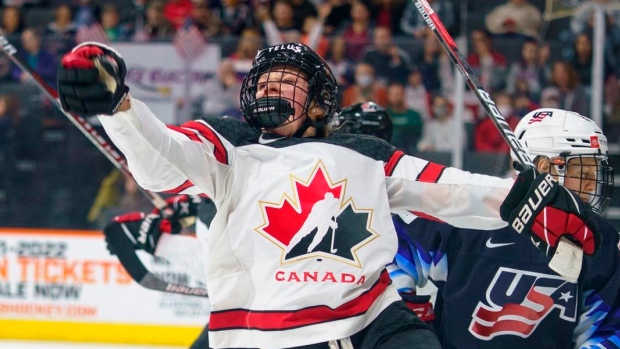Jan 24, 2022
Canadian phenom Fillier poised for breakout at Beijing Games
The first time Sarah Fillier played for Canada's women's hockey team, she found herself looking across a hotel room at her heroine.
The Canadian Press

CALGARY — The first time Sarah Fillier played for Canada's women's hockey team, she found herself looking across a hotel room at her heroine.
A rapt, nine-year-old Fillier watched on television as Marie-Philip Poulin scored twice for Canada in Vancouver en route to Olympic women's hockey gold in 2010.
A teenage Fillier saw Poulin produce the late equalizer and overtime winner to repeat in Sochi, Russia, four years later.
"Seeing her just dominate was always really inspiring," Fillier said.
Those images imprinted in her brain, Fillier overcame her awe of her roommate in order to play with Poulin at the 2018 Four Nations Cup in Saskatoon.
"She was a little shy at first," Poulin recalled.
Fillier wasn't shy on the ice. At 18, she scored in her national-team debut.
The COVID-19 pandemic largely to blame for keeping her off the international hockey stage since then, Fillier is trending towards a breakout performance in Beijing's Winter Olympics.
She may be the youngest player on Canada's Olympic team at 21, but the Georgetown, Ont., forward is among its most dangerous in the offensive zone.
Only Poulin scored more goals than Fillier during Canada's six-month Olympic prep centralization. Poulin amassed 13 goals in 24 games to Fillier's 12 in 26.
Fillier scored three times and assisted on three others in six games in her world championship debut in August. She went on to lead Canada in goals in the Rivalry Series against the United States with five in six games.
"Sarah came ready to go for centralization," Poulin said. "The talent this girl has is pretty impressive. Quick hands, the way she sees the ice, how quick she is, it's is pretty amazing to watch and we're pretty lucky to have her that's for sure."
Canada's head coach Troy Ryan coached Fillier at both the under-18 and development levels and knew her talents. She's proven herself multi-faceted in centralization, however.
"I think the biggest thing for Sarah is just her ability to play the game at such a fast rate," Ryan said. "She can skate well, but she also processes information pretty quick.
"The biggest thing for her success recently has been she's adapted her game to know where she's most effective where maybe in college you see her on the power play, she's coming down the flanks, lets a big shot go.
"Now she's playing a little bit with Poulin on the right side she's dropping down behind the net going where goals are scored and getting some more greasy or goals that sometimes those high-profile or high-skilled players like Sarah don't get."
With the pandemic wreaking havoc on hockey at all levels in 2020-21, Fillier decided to forego her junior year at Princeton, where twin sister Kyla is her teammate, to stay in the Toronto area and skate with national-team players.
Fillier's convinced that move was pivotal in making an immediate impact in her first world championship.
"Just to be able to work every day with people like Brianne Jenner and Natalie Spooner and understand how a national-team player consistently works out and skates, I think it just brought me to another level," Fillier said.
"It's really what got me here today and why I think I had so much success at the world championships and being consistent and contributing."
When she steps on the ice and has the rink to herself for a few moments, Fillier's instincts are to launch into edge work or speed drills with or without the puck.
"I feel like that's always been a cornerstone of my game," she said. "If I was on the ice by myself, I do some tight turns and pivots and laps."
Fillier has avoided the roller-coaster most rookies ride when they make the leap to the national team, said Gina Kingsbury, a two-time Olympic gold medallist now managing the national women's team.
"Sometimes when you're a young athlete, consistency is the last piece to come. You see highs and lows," Kingsbury said. "What's impressed me the most probably of her is that she's been pretty consistent here for the past few months. That's really hard to do it at the level that she plays.
"She's maturing into an incredible athlete that takes her place in the locker room and fits really well with our group. She's a fierce competitor that seems to rise up when the pressure is that is higher."
Her brother Trevor eight years older played hockey "so I spent a lot of time when I was really little around rinks. I wanted to be just like him and that's how I got into hockey," she said.
"Watching the 2010 Olympics in Vancouver and watching the women's and men's team win gold, I kind of knew that I wanted to be on the blue-line and wearing that jersey with a gold medal around my neck."
This report by The Canadian Press was first published Jan. 24, 2022.
